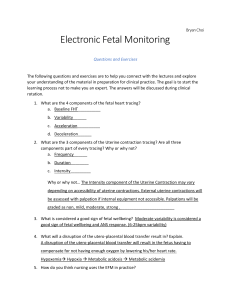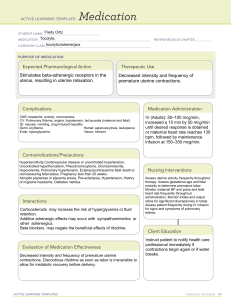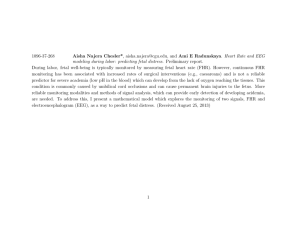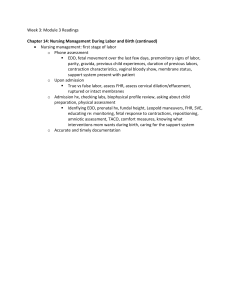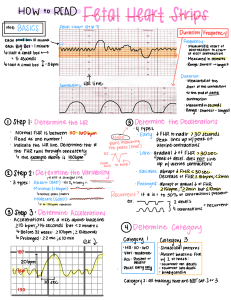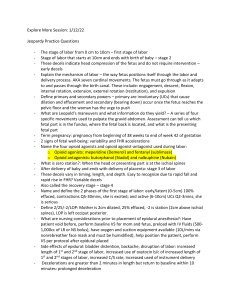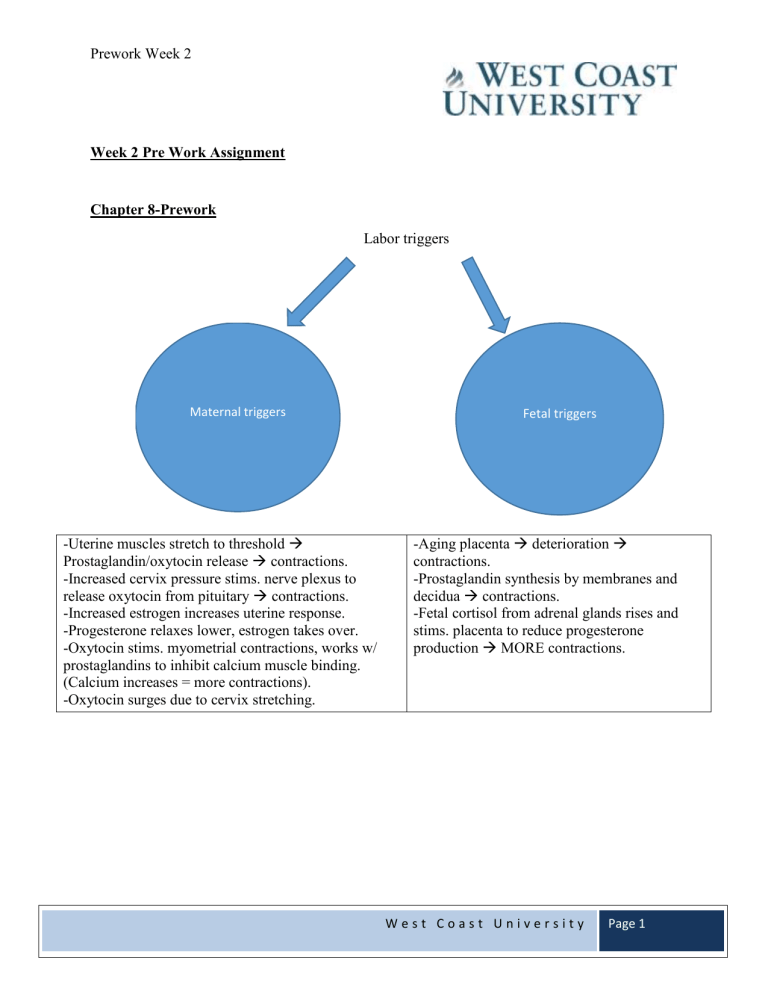
Prework Week 2 Week 2 Pre Work Assignment Chapter 8-Prework Labor triggers Maternal triggers -Uterine muscles stretch to threshold Prostaglandin/oxytocin release contractions. -Increased cervix pressure stims. nerve plexus to release oxytocin from pituitary contractions. -Increased estrogen increases uterine response. -Progesterone relaxes lower, estrogen takes over. -Oxytocin stims. myometrial contractions, works w/ prostaglandins to inhibit calcium muscle binding. (Calcium increases = more contractions). -Oxytocin surges due to cervix stretching. Fetal triggers -Aging placenta deterioration contractions. -Prostaglandin synthesis by membranes and decidua contractions. -Fetal cortisol from adrenal glands rises and stims. placenta to reduce progesterone production MORE contractions. West Coast University Page 1 Prework Week 2 5 P’s of Labor List and explain Power Passenger Position POWER The involuntary contractions of labor and voluntary pushing/beardown. Upper segment pushes fetus down, lower segment thins out and pulls up. -Dilates and effaces. Contractions reduce blood supply and needs resting period to allow O2 to replenish. -Frequency (mins) -Duration (secs) -Intensity (palpated) -Mild, moderate, strong indentation. Phases: -Increment: builds up from fundus to body (longest phase). -Acme: peak of intensity (short). -Decrement: descending and relaxation. Ferguson Reflex: urge to push due to pelvic flood muscle stretch oxytocin and contractions stim. Passageway Psyche PASSENGER PASSAGE POSITION Affected by fetal skull, attitude, lie, presentation, position, and size. -Skull: 2 parietal, 2 temporal, frontal, and occipital bone molds to fit through canal. ID anterior fontanel to determine head position and rotation. -Attitude flexion/extension: term babies have convex back, head flex, chin to chest. -Lie: long fetal axis to long maternal spine axis. Longitudinal (parallel) or transverse (perpendicular and need CS). -Presentation: pole of fetus enters pelvis first cephalic head, breech, or shoulder. Includes bony pelvis and soft tissues of cervix, pelvic floor, vagina, and introitus. Assess pelvis for vag. Delivery through palpation. 6 positions: -Right anterior, transverse, posterior. -Left anterior, transverse, posterior. Types of bony pelvis: -Gynecoid (common) -Android (heart) -Anthropoid -Platypelloid (least common) Divided into false (shallow upper) and true (lower w/ 3 planes: inlet, midpelvis, outlet obstetric cap. Pelvic joints: symphosis pubis, R/L sacroiliac joints, and sacrococcygeal. -Occiput: cephalic -Sacrum: breech -Acromion: shoulder -Mentum: face Position in 3 letters: -1st location of presenting part -R/L -2nd fetal part presenting -O/S/M/A -3rd relationship of fetal part to mom’s pelvis -A/P/T Maternal: freedom of movement to help w/ pain. - 1st Stage: walk, sit, kneel, squat aids descent, reduces supine HOTN, shorter labor, decrease med needs. West Coast University PSYCHE Culture: includes birth traditions. -Who is w/ them during labor? -Pain -Who cares for mom? -Labor response. Expectation: -How is childbirth perceived by woman? -Past experiences (may raise anxiety). Support System: -Helps with decreasing anxiety, pain, and increasing control. -Emotional support, distracting acts., advocate. Adoptive parents: know about relinquishment, feelings, rights to birth mother about experience. Page 2 Prework Week 2 Consider: push duration, parity, epidural, push adequacy, mom/fetal progress, and woman’s preferences. -Presenting part: fetal structure nearest to cervix (attitude and posture determines). Cephalic: head first. Can have vertex flexed, frontum brow slight extension, face, extension of mentum. Breech: complete, Frank, footling. Transverse, compound. Estrogen and relaxin increase soft cartilage and increase ligament elasticity for more fetal head room. -2nd Stage: <push> upright positions help with pelvic outlet increase and aligns fetus. Lithotomy position = most common. Gestational surrogacy: focus on surrogate mom. Labor support: encourage mobility, lessen stress, emotional support. Station: ischial spines and present fetus part festal descent. Station 0 = narrowest. This is where you want mom! Above ischial = neg. Below ischial = pos. At line = 0. Soft tissues: cervix efface/dilates to descend. Pelvic floor helps ant. rotate vag. expands. Premonitory Signs of Labor (5) -ATI o Backache – low dull ache by pelvic muscle relaxation. o Weight loss of 0.5-1.5 kg. o Lightening baby drops lower into pelvis (14 days prior to labor) Breathing is easier. Increased urinary frequency (more pressure on bladder). Especially with primigravida. o Contractions – starts with Braxton-Hicks and increases in strength and regularity. o Bloody show o Loss of mucus plug. o Nesting o GI changes N/V and indigestion o Cervical ripening: softens, opens, efface, dilates. o Rupture of membranes (water breaks) Labor 24 hours after rupture. Prolonged = >24 hours before delivery risk of infection. Assess FHR for decels., distress, and cord prolapse. o Assess amniotic fluid clear, watery, slight yellow, no foul odor, 700-1000 mL. West Coast University Page 3 Prework Week 2 Nitrazine paper confirms (alkaline between 6.5-7.5 or blue paper turns yellow = slightly acidic). <500 mL = amnioinfusion. Mechanisms of Labor/Cardinal movements o Engagement: presenting part (largest) passes pelvic inlet Station 0. o Descent: progress of head, measure in cm. Negative – above ischial spine. Positive – below ischial spine. Station 0 – at ischial spine. o Flexion: fetal head resistance to cervix, pelvic wall, or floor (head flexion, chin to chest smaller diameter passes through). o Internal rotation: head rotates to lateral anterior position (faces back) <think corkscrew>. o Extension: head passes through symphysis pubis head deflected anterior, chin away from chest. o External rotation: restitution head rotated of back and quarter turn to face transverse anterior shoulder passing under symphysis. o Expulsion: trunk born via flexing towards pubis. Ferguson’s Reflex: urge to push due to pelvic floor muscle stretching. o Pitocin secreted uterine contractions. Leopold’s maneuver: inspects and palpates abdomen for fetal position, station, and size. o Determines fetus part at fundus. o Determines fetal back. o Determines presenting part. o Determines head position. West Coast University Page 4 Prework Week 2 4 Stages of Labor Identify and describe the physical changes for each stage. STAGE 1 Cervical changes: 3 phases – starts w/ true labor and ends w/ dilation of 10 cm. -Latent Phase: excited, apprehensive, able to relax and talk through contractions. (Admitted only w/ cervical change, ROM, fetal intolerance of labor). Dilation 0-4 cm. with 0-40% effacement, mild contractions of 3045 sec. every 5-10 min. (like strong cramps). -Active Phase: low energy, internal sensation feeling, increased discomfort. Dilation >6 cm., fetal descent, contractions 45-60 sec. every 2-5 min. -Transition Phase: irritable, discouraged, pissed! Dilation 8-10 cm., contractions 1-1.5 min. every 1-2 min. Bloody show, exhausted, N/V, difficulty concentrating, back pressure, trembling, sweating, urge to bear down. STAGE 2 STAGE 3 STAGE 4 Starts at 10 cm. dilation and ends with birth of baby. After delivery, separation and expulsion of placenta and membranes. Delivery of placenta to 4 hours of stabilization (Postpartum Period). 2 phases: -Uterus contracts, decreases in size, decidual layer separates (takes a few minutes to 30 minutes). -Uterus hardens, umbilical cord lengthens, gush of blood from vagina. Vasoconstriction to achieve hemostasis. -Latent Resting: no urge to bear down. Passive descent of baby. -Active Descent: intense contractions, strong urge to bear down (Ferguson Reflex). Fetus down pelvis and expelled through uterus w/ contractions, tissues stretch. Primigravidas – 50 min. Multigravidas – 20 min. (normal for hours, but no more than 4 hours). Intense contractions every 2 min. (60-90 sec.), more bloody show, flat perineum, rectum/vag. bulge. Closed glottis, direct pushing, nondirected, open glottis 3-4 pushes for 6-8 secs. -Use Pitocin, apply traction at cord, and cord clamping decreases PPH, increases contractions, and expulsion. BUBBLE-HE and VS taken at this time. -Vaginal delivery blood loss 500 in 4 hrs. -C-Section blood loss 1000 in 4 hrs. -Examine placenta and cord after expulsion to make sure it’s intact. Fundal massage prevents hemorrhage. Golden Hour – pushing 4 hours max. West Coast University Page 5 Prework Week 2 Pain management during labor Pharmacological o Pain assessment (intensity, location, pattern, distress, pain scale) and preferences. o Divided into analgesia and anesthesia. Analgesia: Labor established, provide pain reliefe with minimal risk to mom/baby. Neonatal depression w/in 1 hr before delivery. Morphine sulfate resp. depression (caution @ 2nd stage). Butorphanol/Nalbuphine no res. depression. o Not for drug dependent. o Monitor Sublimaze FHR changes, HOTN, CNS depression, resp. depression. o Monitor for sedation, N/V, itching, resp. rate and effort. Anesthesia: Used at time of delivery, episiostomy, or repair. o Local: perineum/episostomy 2nd stage of labor or epi/repair hematoma, infection risk. Monitor for sensation return and swelling at site. Regional for L&D (included pudendal block, epidural, and spinal block). o Pudendal [nerve] 2nd stage, vulva anesthetize, lower vagina, perineum for epi and forcep use. Risk for toxicity, hematoma, infection. Monitor for return sensation, swelling, infection, retention. o Epidural [block] Stage 1-2 of labor for vag or C/S births, with opioids to allow walking. Risk for HOTN, N/V, itching, resp. depression, FHR alterations. Regional or general for C/S delivery. o General (for emergency C/S) Fetal depression, uterine relaxation, vomiting, aspiration. Informed consent! NPO, IV large bore, urinary cath., meds for decreased GI acid, wedge for vena cava prevention. West Coast University Page 6 Prework Week 2 Non-Pharmacological o Prepares woman for childbirth, stim. (cutaneous, thermal, or mental), and have support person. Educational classes for birthing process, expectations, and breathing controls. Relaxation and breathing techs (deep breath beginning contraction, slowly prevents resp. alkalosis). Effleurage: light stroking of abdomen in concentric movement during contraction. Back massage using counterpressure via heel or fist of hand to relieve internal pressure of head. Thermal stimulation: warm or cold packs, showers, baths, numbing cold for pain relief and release. Mental: focal points, imagery, and music. Support: SO or doula provided. o Complementary Therapy Aromatherapy Lavender, jasmine = relaxation and decreased pain perception. Peppermint = decreased nausea. Massage relaxes and decreases pain. Birthing ball Facilitates upright position, pelvis opening, and rolling/bouncing to manage contractions and pain. Hydrotherapy: shower or large tub for endorphin release, muscle tension decrease, and improved circulation. Safe for ruptured membranes. Self-hypnosis: reduce pain and decreas need for anesthesia or analgesia. Music therapy: calms, decrease stress, diverts attention. Acupuncture: improves energy flow, reduce pain/anxiety, labor progression. Sterile water injections o Dick-Read Method Birth w/o fear by education. Environmental control Relaxation o Lamaze Psychoprophylaxis w/ condition and breathing. o Bradley Husband coaching/support. Work with pain and manage. West Coast University Page 7 Prework Week 2 Epidural PREPriority Nursing Interventions/Assessments INTRAPriority Nursing Interventions/Assessments POSTPriority Nursing Interventions/Assessments -Assess pain level. -Determine knowledge/concerns about epidural. -Notify MD and anesthesia about need. -Assess baselines: BP Pulse RR Temp FHR (normal pattern) -Patient voids prior. -Order IV bolus to decrease HOTN risk. -CBC, platelet count, Rh typing, screening orders. -Time out: w/ nurse and anesthesia to ID, site, and verify procedure. -Assist anesthesiologist with epidural placement. -Patient in lateral position with head flexed, towards chest or sitting down, elbows on knees and feet on stool. List List -Monitor VS every 5-15 min. (HOTN, RDS) SOB might = catheter in subarachnoid space. HOTN <100 mmHg or 20% decrease. -Lateral/upright position with uterine displacement to avoid supine HOTN. -Assess pain, effectiveness of meds. -Assess motor blockade level. -Monitor for itching. -Monitor for N/V. -Monitor for post-op headache (spinal fluid leakage = notify). -Monitor urinary retention catheter. Uterine contraction monitoring up to 1 hr. side effects adjust Pitocin. -Intravascular injection (maternal tachy/bradycardia, HTN, dizziness, tinnitus, metallic taste, LOC). Notify, administer O2, fluids, meds, CPR. List -Obtain consent -Check lab values (bleeding, clotting, platelets). -IV bolus with LR. -Emergency equipment check -Time out! N/A. -Injection of local anesthetic or analgesic in epidural space. -Loss of partial sensation may occur. Monitor, do not manage. Dosing is OUT of scope. Assess, monitor, and intervene to minimize complications. Monitor VS, mobility, LOC, pain, and fetal status. -VS every 5 mins., then 15 mins. after re-bolus. -Urinary retention catheterization. -Pain assessment, sensation, motor. -Positioning on side. -Itching, N/V, headache monitoring. West Coast University Page 8 Prework Week 2 Episiotomy and lacerations o Episiotomy First-degree tear: perineal skin and vaginal membrane. Second-degree tear: skin, membrane, and fascia of perineal body. Third-degree tear: skin, mucus membrane, perineal body, muscle, and rectal sphincter. Fourth-degree tear: all the way to rectal mucosa and rectum lumen. o Lacerations Can appear in cervix, vagina, or perineum. What is the priority nursing actions immediately after delivery of the newborn? o Unstable – immediately place baby skin-to-skin with mom w/ blanket over. Do initial assessment from there facilitates contact. Normal vital signs for the newborn: o HR: 110-160 beats/min. o RR 30-60 breaths/min. o BP 65-90/45-65 mmHg (newborns). o Temp: around 97.8-99.5 F (36.5-37.5 C) Chapter 9 Pre-work (you may use outline format) Define: EFM, FSE, Tocodynamometry/IUPC Electronic Fetal Monitoring (EFM) o Fetal assessment based on FHR reflecting oxygenation status. o Done externally and can measure mom and baby. Fetal Scalp Electrode (FSE) o Used with intrauterine pressure catheter (IUPC) when monitoring presenting part of fetus and contractions of patient when membranes are ruptured. Tocodynamometry o Strain gauge used to detect tightness of skin resulting from uterine contractions. o Placed on area of skin where there is strong smooth contraction is felt. Amnioinfusion Option for patients who variable decels. due to lack of amniotic fluid. o Room temp, LR infused transcervically into IUPC to help cushion umbilical cord and reduce cord compression. Bolus usually between 250-500 mL over 20-30 mins. and/or continuous infusion of 120180 mL/hr until 1000 mL is reached. Contraindications: vaginal bleeding, uterine anomalies, or active infection. Monitor response of mom and baby, document, avoid iatrogenic polyhydramnios. Define FHR tracings criteria: Normal fetal baseline range? West Coast University Page 9 Prework Week 2 Mean FHR rounded to 5 beats/min increments within 10 mins. (excludes accels., decels., and variability) at least 2 mins. of baseline segments. 110-160 beats/min. What is variability? And what does it mean? -Fluctuations in baseline FHR and irregular (change in amplitude and frequency) important for predicting adequate fetal oxygenation and fetal reserve during labor. -Baseline: intact pathway from cerebral cortex midbrain (medulla oblongata) vagus nerve heart (SNS/PNS) Absent: No amplitude range detected. BABY LIKELY DEAD. Minimal: Undetected <5 beats/min range. o Fetus sleeping, sedated by CNS depressants (opiates, mag. sulfate, CNS injury, fetal hypoxia, acidosis). Moderate: Amplitude from peak to trough (6 beats/min to 25 beats/min) welloxygenated fetus with normal acid-base balance) Marked: >25 beats/min. What is an acceleration at term >38 weeks gestation and < 38 weeks gestation. -Abrupt onset, transient increase with peaks <30 secs. ->32 weeks: 15 beats above baseline and lasts 15 seconds to less than 2 minutes. -<32 weeks: 10 beats/min or >10 secs. -Prolonged: 2+ mins., less than 10 mins. Caused by SNS response to fetal movement. Transient umbilical vein compression. What is an early deceleration? -Apparent, symmetrical, gradual decrease and return of FHR associated with contraction. -Does not occur early or before contraction. Nadir = lowest point of deceleration peak of contraction. Onset, nadir, recovery mirror contraction. o Caused by pressure on fetal head that stims. vagal nerve. o Fetal head compression increased ICP, decreased cerebral blood flow, decrease in PO2 with stim. of cerebral chemoreceptor. West Coast University Page 10 Prework Week 2 What is a variable? And what does it mean/complications to the fetus -Abrupt decrease in FHR <30 secs. From baseline to nadir (lowest point) most common and can persist over time. Fetal tolerance comes from variability or accelerations. If decels. continue to get deeper and last longer, more associated with fetal acidemia nadir <60 needs amnioinfusion. -Decrease in FHR at least 15 beats/min. lasting 15 secs. And less than 2 min. (U, W, V shape) accels. First and ends with overshoot decels. (non-acidemia), and alter frequency in 2nd stage of labor. -Normal variable decel.: <60 seconds, rapid return to base and variability. -Abnormal or interminate: prolonged return, persistence <60 beats/min., >60 secs, with overshoots and tachycardia, and absent variability. Umbilical cord occlusion, cord compression, umbilical vein compression, umbilical arteries compression (fetal HTN), prolonged cord compression, sudden descent in late active phase. What is a late deceleration and why is it bad for the fetus? -Symmetrical decrease of FHR with UC fetal intolerance to labor. -Gradual onset, nadir lasting at least 30 secs nadir occurs after peak of contraction. -Onset, nadir, and recovery of decel. after UC. -Nadir decrease 10-20 beats/min. Due to uteroplacental insufficiency, decrease O2, suppression of fetal myocardium. W/ minimal/absent variability hypoxia, fetal acidemia. W/ HOTEN due to anesthesia, supine, hemorrhage, HTN, placental changes, lack of HGB or O2 sat, excess uterine contractions. Normal fetal heart rate? 110-160 beats/min. Define a bradycardia. FHR baseline of <110 beats/min lasting longer than 10 min. Labor contractions: What is uterine frequency? Expressed in mins/secs: # contractions every 10 mins. Normal = 5 or fewer contractions in 10 mins over 30 min window. Tachysystole: >5 contractions every 10 mins over 30 min window. West Coast University Page 11 Prework Week 2 What is duration of a uterine contraction? Seconds from beginning to end of contraction expressed as range. What are the variables for a Category I. -Baseline bpm, moderate variability, late/variable decel. not present. Early decel absent/present, accels. absent/present. What are the variables for a Category III. -Absent variability with either recurrent late decels., variable decels.,. bradycardia. -Sinusoidal pattern. Identify VEAL/CHOP Variable decels Cord compression Early decels. Head compression Accelerations Okay Late decels Placental insufficiency Medications: Indication, S/E, Contraindications, Mechanism of Action Terbutaline (Brethine) -Difficulty breathing for COPD patients. -Prevents preterm labor. -May cause changes in breathing, HR. -Can cause: fatigue, tremoring, increased anxiety, changes in consciousness, allergic reaction. -Contraindication: hypersensitivity, prolonged delivery (>48-72 hrs). -MOA: B2 receptors in lungs and uterus stim., causing relaxation, increased breathing capability, and decreased contractions to decrease chance of delivery. Procardia (Nifedipine) -Antihypertensive druge for crises, delays premature labor in women who are not full term. -Can cause: changes in breathing pattern/effort, may encourage vag. bleeding, chest pain, changes in consciousness, and may not stop contractions. -Contraindication: MI, nitrate-containing drug allergies. -MOA: inhibits Ca+ from entering cardiac and uterine muscle so heart is not overworked and does not pump as hard. Reduce muscle contractions and promote vasodilation. Oxytocin (Pitocin) -Hormone/oxytocic used for controlling postpartum bleeding after placental expulsion, inducing labor, and possible abortion of premature fetus (<20 weeks). -Can cause: N/V, changes in heart rhythm, vision, weakness, may cause GI pain, excess bleeding. -Contraindication: allergies, excessive uterine contraction dysfunction, not able to deliver West Coast University Page 12 Prework Week 2 vaginally (placenta previa, cord around neck, infection), if fetus is in bad positioning, fetal distress. -MOA: increase intracellular Ca+ levels and prostaglandins by binding with G-protein receptors to promote increased uterine contractions. Methergine (Methylergonovine) -Stops PP hemorrhaging and manages uterus’ loss of contractions to aid uterus PP return to normal size. -Can cause: changes in BP, heart rhythm, and bleeding. Can increase risk for seizures, GI distress, pain, weakness of muscles, changes in vision. -Contraindications: allergies, HTN, preeclampsia, currently pregnant (decrease blood supply to fetus). Hemabate (Carboprost) -PP hemorrhages and abortion med. for pregnancies 12-20 wks. -Can cause: N/V, diarrhea, bleeding, allergic reactions. -Contraindications: allergies, PID, cardiac disease, renal disease, liver disease, and lung disease. -MOA: impair blood flow by causing uterine contraction (stops blood flow and expels developing fetus). West Coast University Page 13



